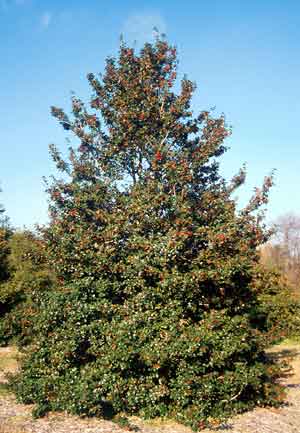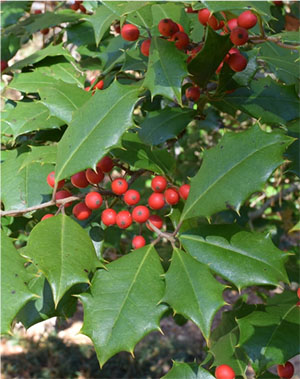American Holly: A Treat for Our Senses
By Carolyn R. Casey, Fairfax Master Gardener
 Are you looking for a beautiful, easy care native evergreen tree for your yard that provides both food and shelter for the birds and also attracts pollinators? Are you also interested in a tree for privacy screening in your backyard? The American holly fulfills all of these requirements.
Are you looking for a beautiful, easy care native evergreen tree for your yard that provides both food and shelter for the birds and also attracts pollinators? Are you also interested in a tree for privacy screening in your backyard? The American holly fulfills all of these requirements.
When we chose our American hollies, we could envision their beautiful green leaves with the red berries cradling the snow during the winter months. We also knew that many of our birds would be attracted to them. We have had our American hollies for 35 years and have enjoyed their beauty year after year.
American holly, Ilex opaca, is a Virginia native and a low maintenance evergreen tree that can grow up to 40 to 60 feet (12 – 18 M) tall and 10 to 20 feet wide (3 – 6 M). It grows well in zones 5 to 9. The American holly grows wild from Pennsylvania and Massachusetts, south through Florida, west to Texas and up through the Midwestern states. It can also be found as an understory tree in forests. It was introduced into the trade in 1744. American holly grows in a pyramidal shape and has over 1,000 cultivars. The Maryland Dwarf cultivar grows 3 to 5 (1 – 1.5 M) feet tall and 8 feet (2.5 M) wide.

Native range
American holly is an acid loving plant whose leaves will turn yellow when planted in alkaline soils. It likes average, moist and well-drained soils but cannot tolerate areas where the soil floods or are inundated with moisture. The American holly likes to be planted in areas with full sun to part shade. It tolerates winter temperatures as low as 20 to 25 degrees F below zero (-6 to -20 C) if protected from drying winds and winter sun.
It has beautiful dark green alternating leaves that have margins between their spines. It also has beautiful smooth gray to whitish bark that complements the dark green leaves.
The American holly needs to have both a female and male plant to produce berries. The small fragrant greenish white flowers bloom in the spring and summer on both the male and female plants; this trait is known as dioecious. The male holly produces the pollen and the female holly produces the berries. Later the flowers will produce beautiful red or orange berries in the fall. These berries will stay on the plant throughout the winter until they are eaten by wildlife. A pound of American holly berries contains 28,430 seeds. It is important to plant one male plant for every three female hollies if you want to have berries on your hollies. The berries are actually four-seeded drupes or pyrenes.
An American holly is pollinated by insects such as bees, wasps, ants, yellow jackets and night flying moths. It provides nectar for pollinators. It is the larval host for Henry’s Elfin, Callophrys henrici, butterfly larvae, which appear from February to May and have one flight. The adult Henry’s Elfin butterflies feed on the flowers’ nectar. Also, honeybees are attracted to the flowers.
 The berries are eaten by songbirds and squirrels and other mammals but are poisonous to cats, dogs, horses and humans. There are over 18 species of birds that eat the berries of American hollies. The endangered red-cockaded woodpecker makes its nest in the American holly tree. Also the American holly provides shelter and protection for the birds and squirrels throughout the winter months. It is also deer resistant. The wood of the American holly is used to make furniture, canes, veneer, cabinets, scientific instruments, knife handles and (because it holds dye well) piano keys and pegs or fingerboards. Some Native American tribes used the holly berries to make and trade buttons.
The berries are eaten by songbirds and squirrels and other mammals but are poisonous to cats, dogs, horses and humans. There are over 18 species of birds that eat the berries of American hollies. The endangered red-cockaded woodpecker makes its nest in the American holly tree. Also the American holly provides shelter and protection for the birds and squirrels throughout the winter months. It is also deer resistant. The wood of the American holly is used to make furniture, canes, veneer, cabinets, scientific instruments, knife handles and (because it holds dye well) piano keys and pegs or fingerboards. Some Native American tribes used the holly berries to make and trade buttons.
The leaves and berries of the American holly have been used for centuries as holiday decorations. In the early 1900s, holly decorations were so popular at Christmas that people were cutting down and stealing holly trees from other people’s property. Maryland and Delaware outlawed the sale of fresh holly in an attempt to stop these holiday thefts.
The American holly is also referred to as white holly or Christmas holly, and it is one of the most popular and valuable trees in the eastern United States for its foliage and berries. Some people believed that American hollies would ward off witchcraft and protect their homes from lightning strikes.
The American holly grows into quite a large plant and is best suited for yards where it has lots of room to grow. The best time to prune American holly is in the winter when it is dormant. Since the leaves have spines, it is a good idea to wear gloves and/or long sleeves. Prune out any dead and damaged branches. Always make the cut at a node, just above a lateral bud. Prune so as to maintain the natural shape of the holly. It has a high flammability rating and should not be planted close to a home.
Leaf miners and scale can be a problem for the American holly along with some other insects. It is also affected by powdery mildew and leaf scorch.
When you are looking for trees or shrubs to use for privacy screening, consider the American holly. It is an easy to care for plant that attracts many pollinators and provides food and shelter for the birds and many other animals during the winter months. Happy Gardening!
Resources
• American Holly, T. Zurek, Glen Arboretum, Towson University
• Ilex opaca, North Carolina State Extension Gardener Plant Toolbox
• American Holly, Robert F. Polomski, Clemson Cooperative Extension Home and Garden Information
Center
• American Holly, University of Kentucky College of Agriculture, Food and Environment
• American Holly, H.E. Grelen, United States Department of Agriculture
• Ilex opaca, Missouri Botanical Garden